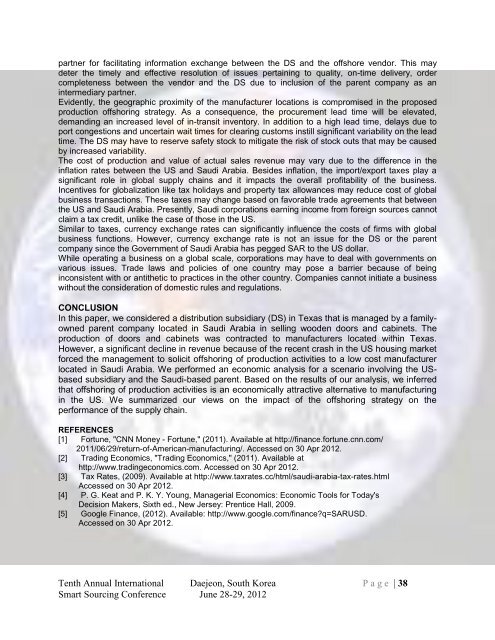of 3 - Center for Global Outsourcings
of 3 - Center for Global Outsourcings
of 3 - Center for Global Outsourcings
Create successful ePaper yourself
Turn your PDF publications into a flip-book with our unique Google optimized e-Paper software.
partner <strong>for</strong> facilitating in<strong>for</strong>mation exchange between the DS and the <strong>of</strong>fshore vendor. This may<br />
deter the timely and effective resolution <strong>of</strong> issues pertaining to quality, on-time delivery, order<br />
completeness between the vendor and the DS due to inclusion <strong>of</strong> the parent company as an<br />
intermediary partner.<br />
Evidently, the geographic proximity <strong>of</strong> the manufacturer locations is compromised in the proposed<br />
production <strong>of</strong>fshoring strategy. As a consequence, the procurement lead time will be elevated,<br />
demanding an increased level <strong>of</strong> in-transit inventory. In addition to a high lead time, delays due to<br />
port congestions and uncertain wait times <strong>for</strong> clearing customs instill significant variability on the lead<br />
time. The DS may have to reserve safety stock to mitigate the risk <strong>of</strong> stock outs that may be caused<br />
by increased variability.<br />
The cost <strong>of</strong> production and value <strong>of</strong> actual sales revenue may vary due to the difference in the<br />
inflation rates between the US and Saudi Arabia. Besides inflation, the import/export taxes play a<br />
significant role in global supply chains and it impacts the overall pr<strong>of</strong>itability <strong>of</strong> the business.<br />
Incentives <strong>for</strong> globalization like tax holidays and property tax allowances may reduce cost <strong>of</strong> global<br />
business transactions. These taxes may change based on favorable trade agreements that between<br />
the US and Saudi Arabia. Presently, Saudi corporations earning income from <strong>for</strong>eign sources cannot<br />
claim a tax credit, unlike the case <strong>of</strong> those in the US.<br />
Similar to taxes, currency exchange rates can significantly influence the costs <strong>of</strong> firms with global<br />
business functions. However, currency exchange rate is not an issue <strong>for</strong> the DS or the parent<br />
company since the Government <strong>of</strong> Saudi Arabia has pegged SAR to the US dollar.<br />
While operating a business on a global scale, corporations may have to deal with governments on<br />
various issues. Trade laws and policies <strong>of</strong> one country may pose a barrier because <strong>of</strong> being<br />
inconsistent with or antithetic to practices in the other country. Companies cannot initiate a business<br />
without the consideration <strong>of</strong> domestic rules and regulations.<br />
CONCLUSION<br />
In this paper, we considered a distribution subsidiary (DS) in Texas that is managed by a familyowned<br />
parent company located in Saudi Arabia in selling wooden doors and cabinets. The<br />
production <strong>of</strong> doors and cabinets was contracted to manufacturers located within Texas.<br />
However, a significant decline in revenue because <strong>of</strong> the recent crash in the US housing market<br />
<strong>for</strong>ced the management to solicit <strong>of</strong>fshoring <strong>of</strong> production activities to a low cost manufacturer<br />
located in Saudi Arabia. We per<strong>for</strong>med an economic analysis <strong>for</strong> a scenario involving the USbased<br />
subsidiary and the Saudi-based parent. Based on the results <strong>of</strong> our analysis, we inferred<br />
that <strong>of</strong>fshoring <strong>of</strong> production activities is an economically attractive alternative to manufacturing<br />
in the US. We summarized our views on the impact <strong>of</strong> the <strong>of</strong>fshoring strategy on the<br />
per<strong>for</strong>mance <strong>of</strong> the supply chain.<br />
REFERENCES<br />
[1] Fortune, "CNN Money - Fortune," (2011). Available at http://finance.<strong>for</strong>tune.cnn.com/<br />
2011/06/29/return-<strong>of</strong>-American-manufacturing/. Accessed on 30 Apr 2012.<br />
[2] Trading Economics, "Trading Economics," (2011). Available at<br />
http://www.tradingeconomics.com. Accessed on 30 Apr 2012.<br />
[3] Tax Rates, (2009). Available at http://www.taxrates.cc/html/saudi-arabia-tax-rates.html<br />
Accessed on 30 Apr 2012.<br />
[4] P. G. Keat and P. K. Y. Young, Managerial Economics: Economic Tools <strong>for</strong> Today's<br />
Decision Makers, Sixth ed., New Jersey: Prentice Hall, 2009.<br />
[5] Google Finance, (2012). Available: http://www.google.com/finance?q=SARUSD.<br />
Accessed on 30 Apr 2012.<br />
Tenth Annual International Daejeon, South Korea P a g e | 38<br />
Smart Sourcing Conference June 28-29, 2012



